World of Activity #5: The Creative Thematic Curation Framework

The Themes of Practice and the Journey of Project Engagement

The Creative Thematic Curation Framework explores the concept of "Theme" within the Developmental Project model from the "Self" perspective.
by Oliver Ding
This article is part of the World of Activity series on the Activity Analysis site. In this series, we use the World of Activity toolkit as a creative heuristic to explore new themes and encourage discussions around resonant topics with your friends and colleagues.
In this article, we introduce the Creative Thematic Curation framework as a sub-framework of the Project Engagement Approach (V3.1). It connects to the Developmental Project model through the concept of "Theme" within the journey of Project Engagement.
Contents
1. The Project Engagement Approach (v3.1)
2. Themes of Practice and Project Engagement
3. The Creative Thematic Curation Framework
3.1 Five Movements
3.2 Second-wave Development
3.3 Third-wave Development
3.4 Subjectification and Objectifcation
3.5 Experience 1 and Experience 2
3.6 First-order Activity and Second-order Activity
4. The Journey of Project Engagement and Crytallize Thematically
5. Case Study: James Currier and the Theme of "Network Effects" (2022)
5.1 The Subjectification Stage
5.2 The Turning Point
5.3 The Objectification Stage
6. Case Study: The Journey of Engaging with Activity Theory (2022)
6.1 Explore Widely
6.2 Inquire Deeply
6.3 Crystallize Thematically
6.4 Work Deeply
6.5 Play Widely
6.6 Second-wave Development
6.7 Third-wave Development
6.8 Reflecting on the Journey in 2025
7. Case Study: Oliver Ding and the Theme of Curativity (2022)
7.1 Explore Widely
7.2 Inquire Deeply
7.3 Crystallize Thematically
7.4 Work Deeply
7.5 Play Widely
7.6 Second-wave Development
7.7 Third-wave Development
7.8 Reflecting on the Journey in 2025
8. Case Study: The Journey of Building Creative Life Theory (2023)
8.1 A Brief Overview of the “Creative Life Theory” Knowledge Journey
8.2 Multi-theme Development
8.3 Explore Widely
8.4 Inquire Deeply
8.5 Crystallize Thematically
8.6 Work Deeply
8.7 Second-wave Development
8.8 Third-wave Development
8.9 Reflecting on the Journey in 2025
9. Mapping One Creative Journey
1. The Project Engagement Approach (v3.1)
In May 2024, I developed version 3.1 of the Project Engagement approach. While version 1.0 focused on the Developmental Project Model, version 3.0 expanded on this by curating a range of knowledge frameworks to explore project-oriented social ecology.
This is a comprehensive theoretical toolkit, as illustrated in the diagram below.

The diagram consists of two key components:
- The top section represents a Map.
- The bottom section - also called the Model part - showcases several knowledge frameworks.
While the Map represents multiple aspects of project-oriented social ecology, the Model features relevant knowledge frameworks for understanding these aspects.
It also uses some key terms to connect the Map part and the Model part. For example, the term "Self" is used to connect the Creative Thematic Curation framework with the Developmental Project model.
The Developmental Project model can be used from two perspectives, the Self perspective, which focuses on individuals as project members, and the Project perspective, which focuses on the project itself.
In version 3.1, the Self perspective is used to introduce the Creative Thematic Curation framework as part of the toolkit.
2. Themes of Practice and Project Engagement
The concept of Themes of Practice is central to Curativity Theory, serving as a bridge between life themes and cultural themes.
Anthropologist Morris Opler (1945) introduced the theoretical concept of themes to study culture. Similarly, career counseling therapists and psychologists developed the concept of life themes. When cultural themes and life themes are considered together, they reveal a critical debate in the social sciences: the relationship between the individual and the collective.

I view Themes of Practice as a process-oriented concept rather than a substance-oriented concept. Rather than introducing a new category of themes, it emphasizes the transformational process that bridges individual life themes with collective cultural themes. This concept integrates both conceptual understanding and practical action, linking mind and practice while highlighting the transformation of both individuals and society.
In 2021, while working on Project-oriented Activity Theory, I discovered a connection between the notion of Themes of Practice and Andy Blunden’s concept of Formation of Concept.

After reading Blunden’s book Concepts: A Critical Approach, which presents a Hegel-Marx-Vygotsky account of Concept, I realized that it serves as a crucial theoretical resource for supporting my idea of Themes of Practice. According to Blunden, “Dualism has been around for a long time, and not only in the form of mind/matter dualism. One of the most persistent and debilitating forms of dualism today is the dualism of the individual and society, supported by sciences devoted exclusively to one or the other domain. Since concepts are units both of cultural formations and individuals minds, a theory of concepts confronts this head on…The development of the human sciences along two parallel paths, one concerned with human consciousness, the other concerned with social and political phenomena, can only serve to place barriers in front of people’s efforts to intervene in the affairs determining their own life. By understanding concepts as units of both consciousness and the social formation, I aim to create a counter to this disempowering dogma.” (2012, p.9)
Blunden’s argument on Concept echoes my consideration of the concept of Theme. Since Theme is a particular type of concept, I can adopt Blunden’s Hegel-Marx-Vygotsky account of Concept as a theoretical foundation for Themes of Practice.
This theoretical foundation establishes the connection between the Developmental Project model and the Creative Thematic Curation framework.
3. The Creative Thematic Curation Framework
The Creative Thematic Curation framework was originally called the Creative Life Curation framework. In November 2022, I wrote a book draft on Creative Life Curation and developed several frameworks, including the one highlighted below.
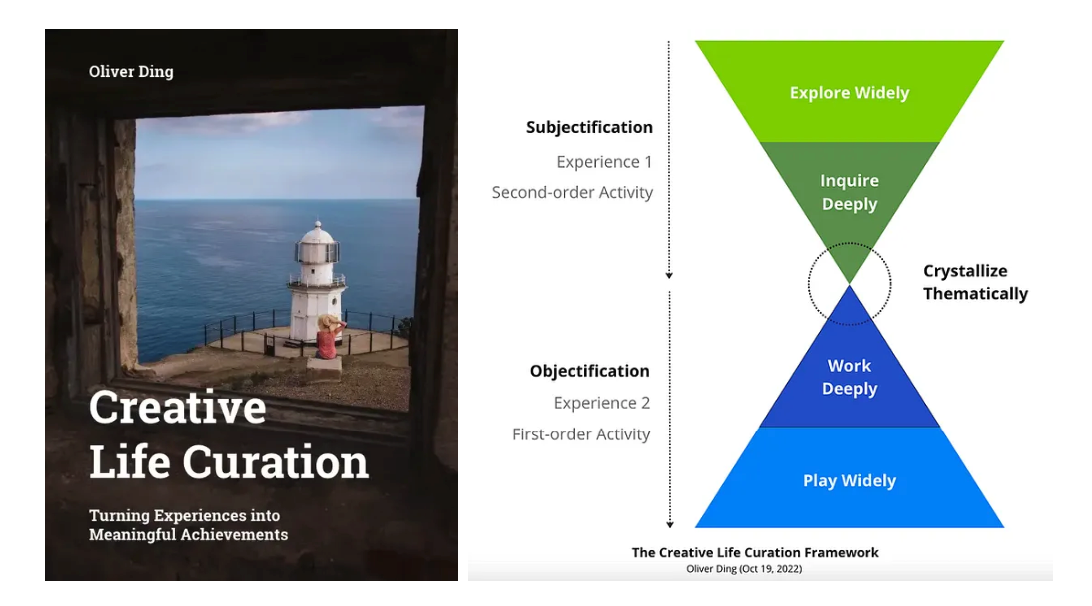
Later, I detached the framework from the Creative Life Curation method and turned it into a general framework with a new name: Creative Thematic Curation.
3.1 Five Movements
The model outlines five movements that represent the journey of project engagement. Together, these movements provide a basic model for understanding a series of projects as a meaningful whole:
- Explore Widely
- Inquire Deeply
- Crystallize Thematically
- Work Deeply
- Play Widely
In addition, the model uses First-wave, Second-wave, and Third-wave to describe the dynamics of project engagement, particularly in the context of multi-year journeys.
3.2 Second-wave Development
Second-wave development signifies a return to the first stage, initiating a new cycle in the journey.

The model is divided into Objectification and Subjectification. The upper part represents the Subjectification part, while the lower part represents the Objectification part.
In the second-wave development of a journey, the change may focus on the Objectification part. See the diagram below.
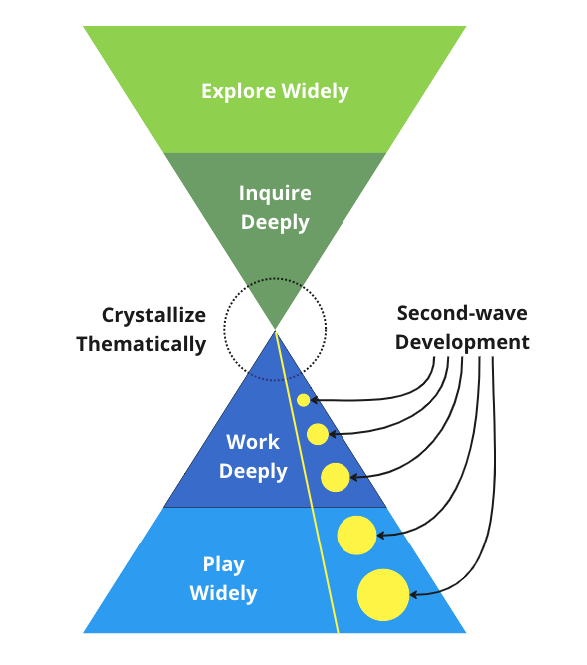
3.3 Third-wave Development
The third-wave development situates the Journey within a border context. It explores the dynamics of a project network and the creative thematic dialogue.
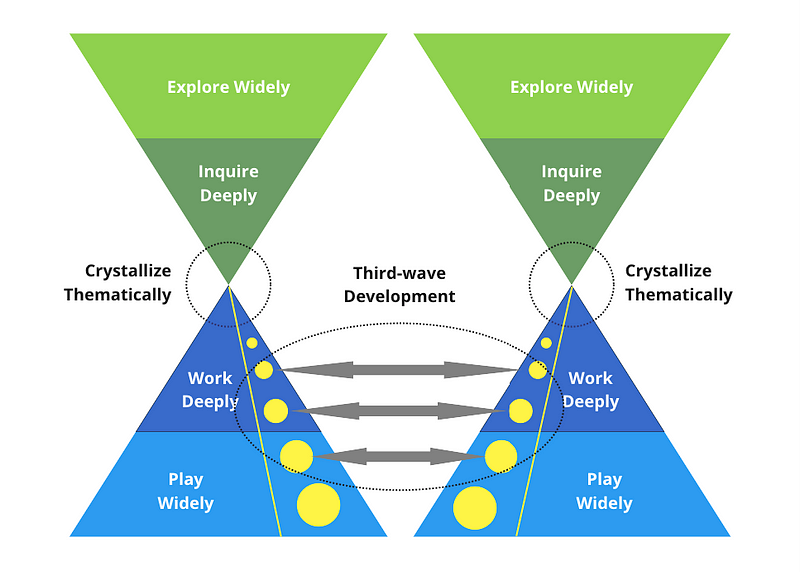
3.4 Subjectification and Objectifcation
The model divides the process into two tendencies:
Subjectification
- Experience 1: turning the world into a person’s experience.
- This echoes Second-order Activity.
Objectification
- Experience 2: turning the person’s experience into artifacts for the world.
- This echoes First-order Activity.
These terms link to the General Curation framework and the Anticipatory Activity System (AAS) framework.
3.5 Experience 1 and Experience 2
The terms Experience 1 and Experience 2 connect to the General Curation framework. See the diagram below.

As an application of Curativity Theory, the General Curation framework represents the structure and dynamics of general curation practice. The goal of general curation is to collect individual pieces and assemble them into a meaningful whole, presenting a theme to a group audience.
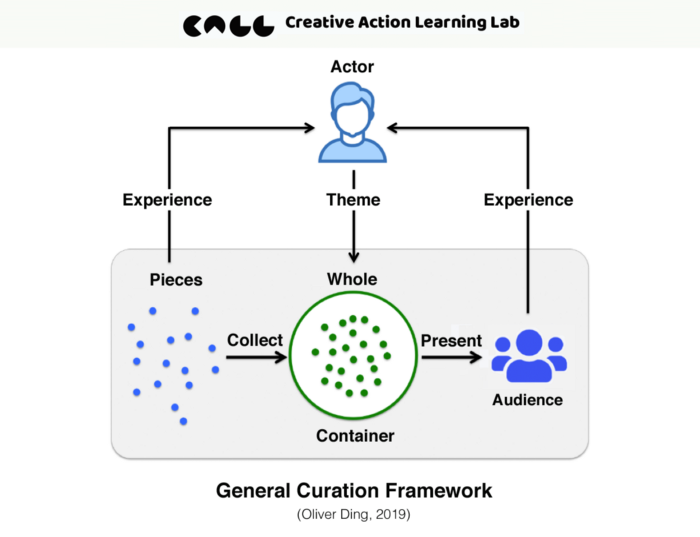
The diagram highlights several concept pairs:
- Pieces vs. Whole
- Whole vs. Container
- Collect vs. Present
- Actor vs. Audience
- Experience vs. Theme
in this context, Experience 1 refers to turning the world into a person’s experience. Within the Creative Thematic Curation framework, this means Collecting pieces of life experiences.
Experience 2 refers to turning the person’s experience into artifacts for the world. For the Creative Thematic Curation framework, this means Presenting a new meaningful whole to a group audience.
The key transformation between Experience 1 and Experience 2 is Crystallize Thematically – the process of discovering a match between individual life themes and collective cultural themes.
3.6 First-order Activity and Second-order Activity
The terms First-order Activity and Second-order Activity come from the Anticipatory Activity System (AAS) framework.
While First-order Activity refers to normal activities as defined by traditional Activity Theory, Second-order Activity is a higher-order process in which subjects focus on defining objectives and goals for their further normal activities.
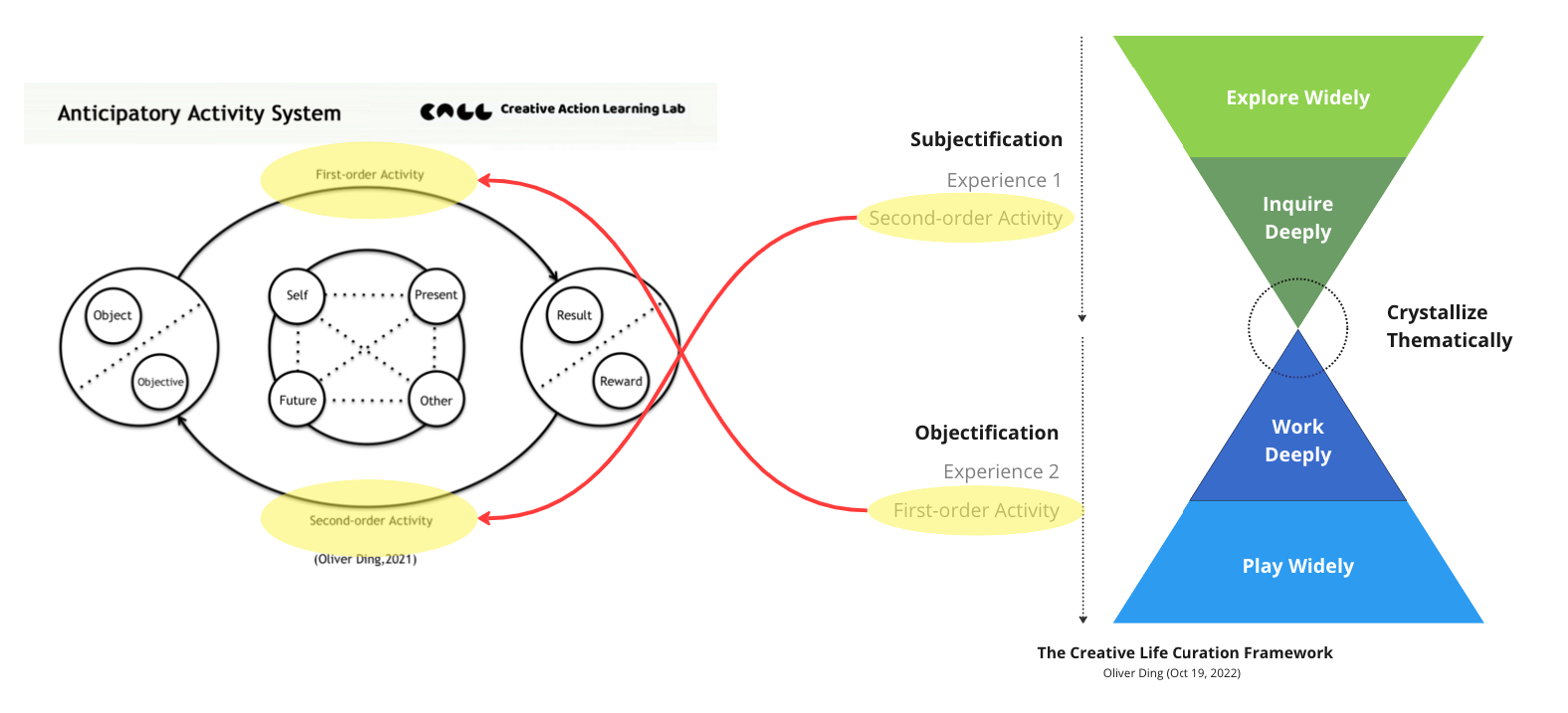
In the Creative Thematic Curation framework, the process of Subjectification involves turning the world into a person’s experience. The outcome of Subjectification is a match between individual life themes and collective cultural themes.
This match, also called the process of Crystallize Thematically, determines the direction of the process of Objectification.
In this context, Objectification corresponds to First-order Activity, focusing on concrete actions and outcomes. Subjectification corresponds to Second-order Activity, emphasizing reflection, meaning-making, and goal-setting.
4. The Journey of Project Engagement and Crytallize Thematically
In the Project Engagement approach (v3.1), the concept of Journey is defined as a series of interconnected projects that form a meaningful developmental process. This framework considers a journey to involve at least four or more projects.
In February 2022, I applied the Project Engagement approach to understanding Life Discovery Activity.
Over time, I have developed multiple frameworks exploring Life Discovery and Life Development from different perspectives. A key challenge in this work is balancing the individual perspective and the collective perspective—a fundamental issue in the social sciences. This tension is reflected in long-standing theoretical debates, such as psychological vs. sociological perspectives, methodological individualism vs. methodological collectivism, etc.
Some scholars don’t consider the dichotomy a problem and they just form two camps. Other scholars developed theoretical solutions to solve the theoretical conflict between these two camps. Inspired by Derek Layder’s Social Domains Theory (1997) and Andy Blunden’s “Project as a Unit of Activity” (2010, 2014), I adopted the concept of “Project” as a Container for understanding life.

Andy Blunden describes a project-oriented approach as encompassing both psychology and sociology: “A project is a focus for an individual’s motivation, the indispensable vehicle for the exercise of their will and thus the key determinant of their psychology and the process which produces and reproduces the social fabric. Projects, therefore, give direct expression to the identity of the sciences of the mind and the social sciences. Projects belong to both; a project is a concept of both psychology and sociology.” (Blunden, 2014, p.15)
The concept of Life can be understood in two dimensions: Collective Life and Individual Life. The concept of Project serves as a bridge between these two perspectives. A person’s real life consists of a set of real actions. The Project concept offers a way to curate these actions into a meaningful structure. Similarly, collective experiences and social dynamics can be curated through Projects as well.
Beyond individual projects, the concept of Journey introduces a new unit of analysis—a way to explore the chain of interconnected projects over time. Various approaches can be used to analyze a Journey of Project Engagement. The Creative Thematic Curation framework specifically focuses on the "Themes of Practice" aspect of a Journey. (See the diagram below.)

The diagram above connects the Developmental Project model, the basic model of Thematic Space, and the Creative Thematic Curation framework together.
While the Developmental Project model consists of eight elements, this article focuses specifically on the "Theme" aspect of projects. As discussed earlier, we apply the Themes of Practice framework to examine how a theme evolves within the Journey of Project Engagement.
In this context, the development of a theme can be understood as a dynamic change within a thematic space.
A Thematic Space refers to a cognitive space where a person’s ideas, activities, and practices revolve around a particular theme. A theme can take various forms, such as an established theory (e.g., “Activity Theory”), a general concept (e.g., “Platform,” “Life”), or an idea somewhere in between(e.g., “Design Thinking,” “UX”).
I often use a three-layer model to understand a thematic space.
- Aspect of Life Experiences: Creative Life Story
- Subjective Aspect of Knowledge: Creative Theme
- Objective Aspect of Knowledge: Knowledge Model

In this article, we use the following terms to describe these three layers:
- Experiences
- Theme
- Knowledge
Each project brings various real-life experiences to a thematic space, inspiring us to develop our understanding of the theme. At the same time, we engage with knowledge—including theories, concepts, knowledge frameworks, and methods—to further refine and enrich our understanding of the theme.
In the Creative Thematic Curation framework, the dynamic evolution of a thematic space corresponds to the Subjectification part. Over time, this process reaches a turning point, leading to what we call the "Crystallize Thematically" movement.
For example, in my journey of developing the theme of Curativity, the "Crytallize Thematically" movement was marked by coining the term "Curativity" and writing a 615-page book draft between October 2018 and March 2019.
However, the “Crystallize Thematically” movement is not limited to writing a book or developing a new theory. There are many ways to take action in the “Crystallize Thematically” movement.
A creative person can use existing words to name their life themes without writing a book. For example, James Currier, a five-time founder, named his venture capital firm NFX which stands for Network Effects – a crucial mechanism behind fast-growing startups. Over the past 20 years, his journey has embodied the Creative Thematic Curation framework, as he explored, deepened, and ultimately crystallized the theme of Network Effects through both practice and articulation.
As mentioned earlier, the Creative Thematic Curation framework was originally called the Creative Life Curation framework. By connecting the framework with the Journey of Project Engagement, we establish a creative heuristic tool for transforming a series of projects into a coherent journey of Creative Life.
5. Case Study: James Currier and the Theme of "Network Effects" (2022)
In 2022, I conducted a case study using James Currier's journey of project engagement to test the Creative Thematic Curation framework.
James Currier, a five-time founder, named his venture capital firm NFX, short for Network Effects.
Before becoming an investor, he first encountered the power of network effects through his startup Tickle. According to his profile, “James was the co-founder and CEO of Tickle, one of the internet’s first successful user-generated companies. Tickle grew to the 18th largest website in the world with over 150 million registered users — before they were acquired in 2004 by Monster for $110 million. It was during this time that James realized the power of network effects as the core growth driver of both B2B and B2C successes across every vertical.”
Building on this realization, James founded NFX Capital in 2017, dedicating his work to studying and sharing knowledge about network effects. In May 2018, he published The Network Effects Bible, further crystallizing his thematic exploration.
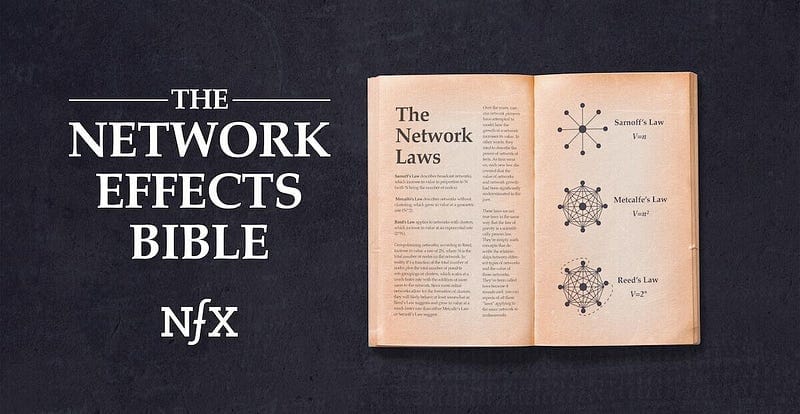
In October 2022, he launched the Network Effects Masterclass, offering 11 episodes for free.
James’ story revolves around the theme of “Network Effects”, a crucial mechanism for the rapid growth of startups. Over the past 20 years, he has gone through the entire process of the Creative Life Curation Framework, turning his understanding of network effects into a guiding principle for his ventures and investments.
5.1 The Subjectification Stage
This stage is about turning the world into a person’s experience. In this stage, James developed his life from a startup founder to a successful venture investor. This is about “Explore Widely” and “Inquire Deeply”.
This stage involves turning the world into a person’s experience. For James, this was about his transition from a startup founder to a successful venture investor. It represents the "Explore Widely" and "Inquire Deeply" movements in the framework, as he worked on various projects and learned from his entrepreneurial experiences.
5.2 The Turning Point
At this moment, James identified a theme that not only encapsulated his life’s journey but also addressed a strong sociocultural need. This theme highlights the significance of Network Effects as a core mechanism for startups in the networked age. He even used this theme as the name for his venture capital firm: NFX.
5.3 The Objectification Stage
The Objectification stage is about turning a person’s experience into artifacts for the world. In James’ case, these "artifacts" include articles, the Network Effects Bible, and the Network Effects Masterclass, all of which he created to share his insights and knowledge. This stage exemplifies the process of discovering a match between individual life themes and collective cultural themes.
6. Case Study: The Journey of Engaging with Activity Theory (2022)
In November 2022, I conducted a case study on my journey of engaging with Activity Theory, focusing on the Activity U project (2020) and other related projects.
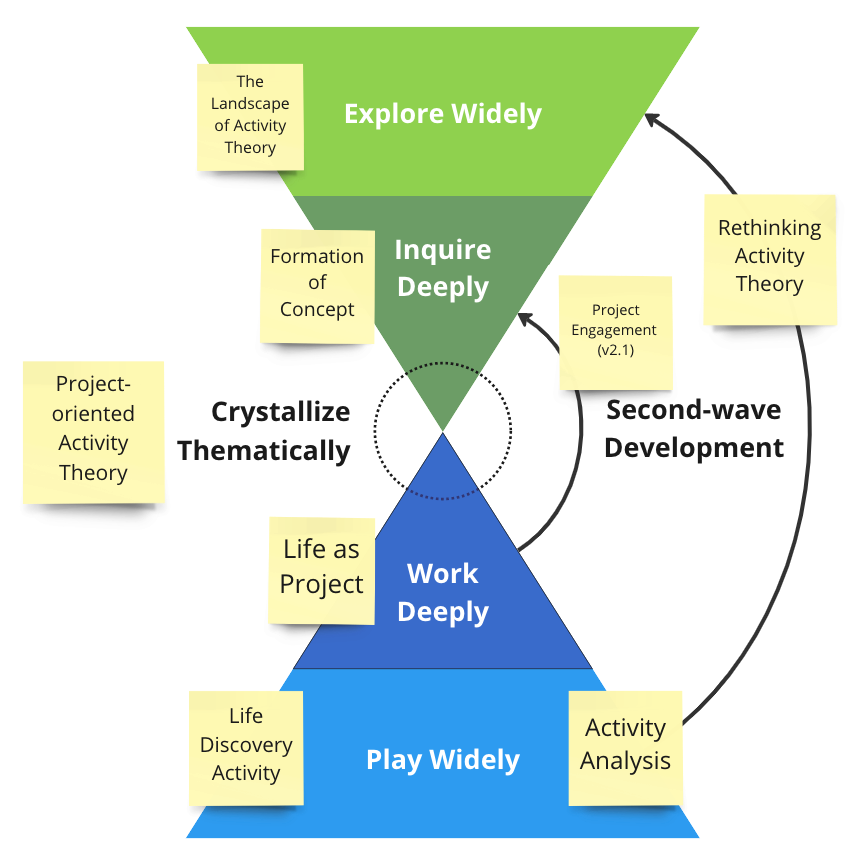
This case study only uses First-wave Development and Second-wave Development. See the details below.
6.1 Explore Widely
I started the Activity U project on August 19, 2020, initially as an experiment with the “HERO U” framework. The project began with a single diagram, Activity U, which mapped out key aspects of Activity Theory. To provide context, I wrote a post titled: Activity U: The Landscape of Activity Theory.
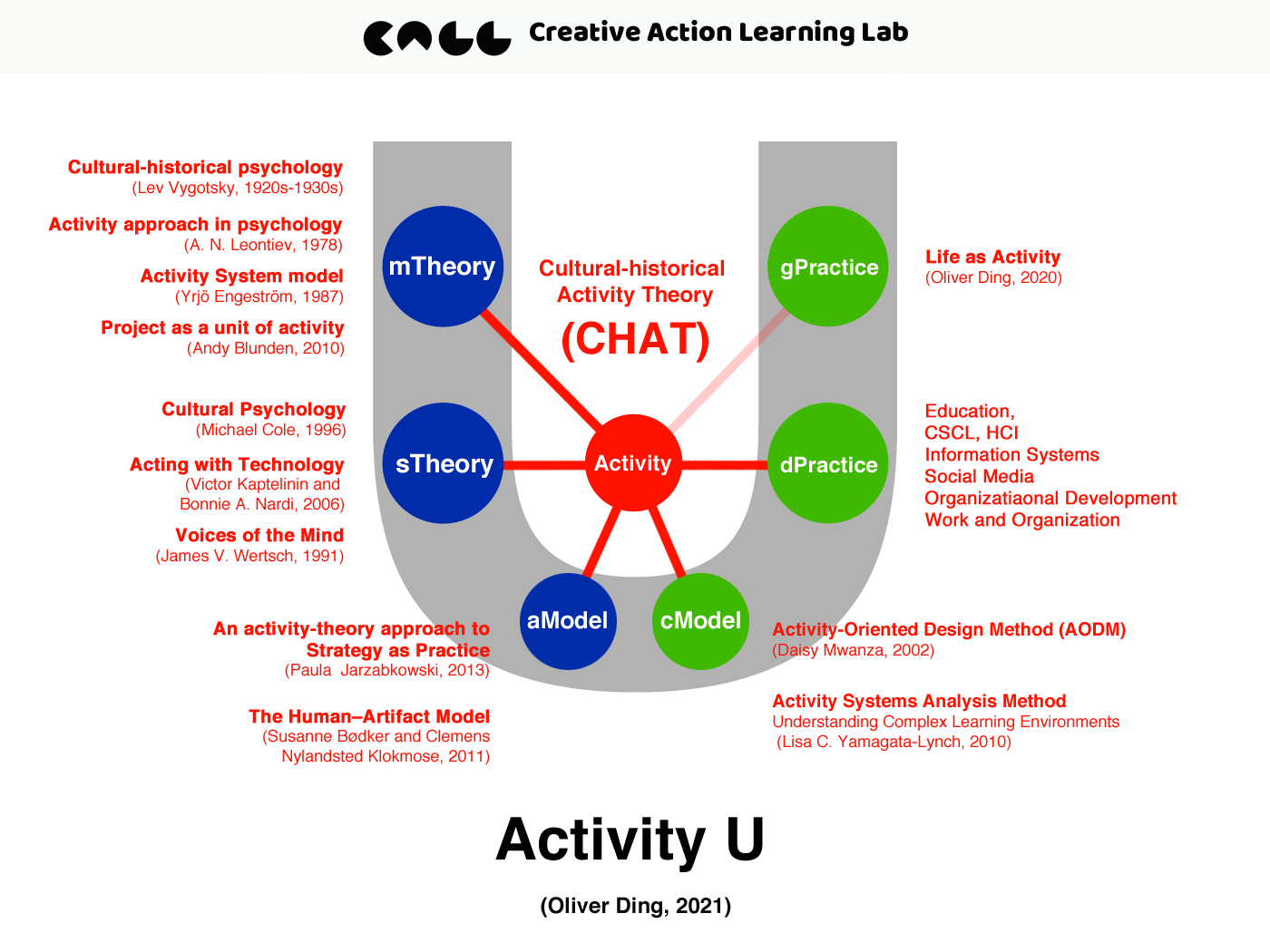
Later, I expanded the article into a series of posts, eventually appending "(Part I)" to the original title to signal its continuation.
On December 8, 2020, I collected my articles about Activity Theory and edited a book draft titled Activity U: How to Think and Act Like an Activity Theorist.
In fact, Activity Theory is not one theory, but a group of theories. For this particular case, Explore Widely means exploring the landscape of Activity Theory and touching on many theoretical approaches of the field of Activity Theory, not only one theoretical approach.
6.2 Inquire Deeply
During my exploration of Activity Theory, I discovered Andy Blunden’s 2010 book, An Interdisciplinary Theory of Activity through an activity theorist's blog. This discovery led me to a deeper engagement with Blunden’s work, as I realized that his contributions represented a major theoretical development in Activity Theory over the past decade.
To develop the theoretical foundation for “Project as a unit of Activity,” Blunden adopts Hegel’s logic and Vygotsky’s theory of Concepts as key theoretical resources. The process is documented in three books: An Interdisciplinary Theory of Activity (2010), Concepts: A Critical Approach (2012), and Collaborative Projects: An Interdisciplinary Study (2014).
After deliberately reviewing the unique theoretical concept of “Project-oriented Activity Theory,” I was drawn to its significance and potential. I also found several of my own ideas aligning with Blunden’s approach. Moreover, his theoretical framework provided valuable support for two of my frameworks: the Life-as-Activity approach and the Platform for Development framework.
I designed a series of diagrams to represent Andy Blunden's ideas. My approach was unique in that I started by creating a "germ-cell" diagram for his concept and then expanded it into a network of interconnected diagrams.
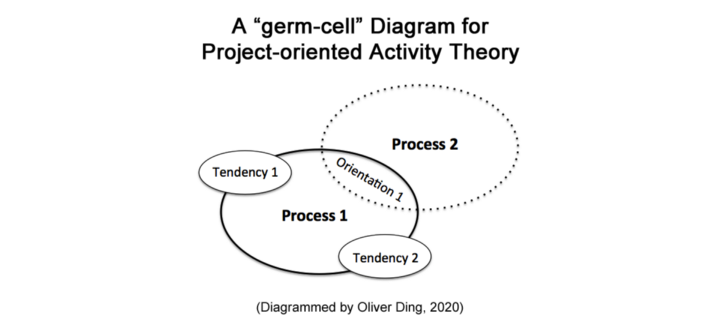
There are many ways to Inquire Deeply – for me, translating theoretical texts into diagrams was an effective method for engaging deeply with Blunden’s ideas.
6.3 Crystallize Thematically
Eventually, I wrote five articles on "Project-Oriented Activity Theory." While Blunden does not use this term to define his approach, I adopted it to refer to both his framework and my interpretation of it. Additionally, I expanded Blunden’s approach by integrating new ideas from Ecological Psychology.
- Project as a Unit of Activity (40 min read, Dec 26, 2020)
- Project-oriented Activity Theory (50 min read, Jan 3, 2021)
- Projecting, Projectivity, and Cultural Projection (26 min read, Jan 9, 2021)
- Process, Position, and Zone of Project (47 min read, Jan 18, 2021)
- 136 Ideas for Impact Projects and Micromovements (18 min read, Jan 20, 2021)
Later, on Jan 24, 2022, I edited a new book draft titled Project-oriented Activity Theory
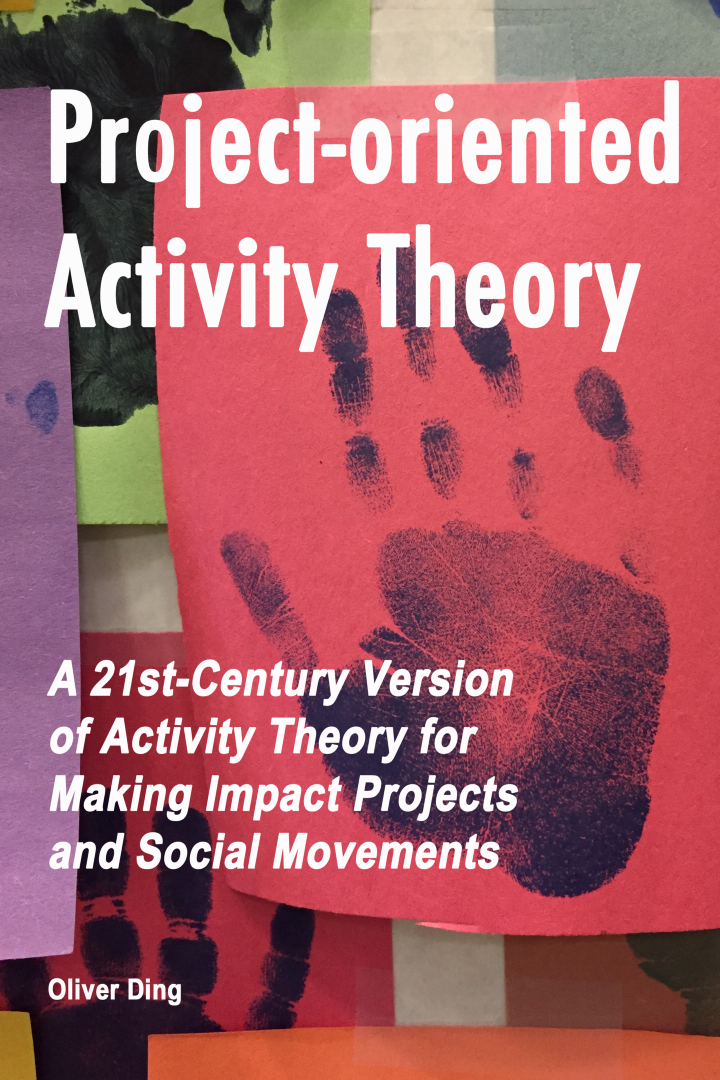
Though these articles serve as my learning notes, they also function as a proposal, as I introduced many new ideas to expand Blunden’s original approach.
This marked the Crystallize Thematically movement. Moreover, it represented Multi-them Development.
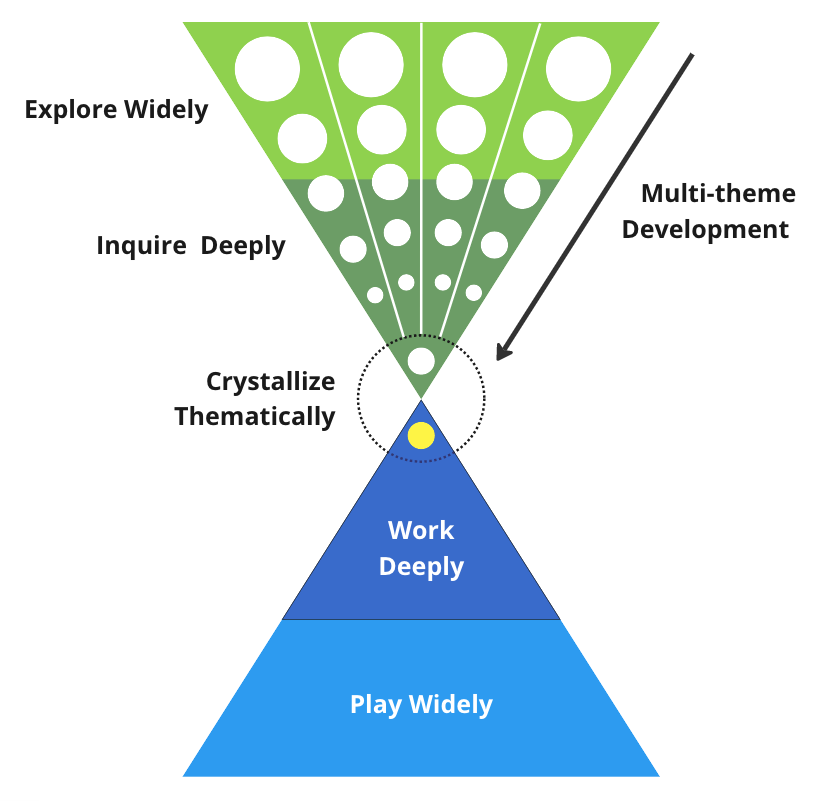
The following list helps distinguish Blunden’s original approach from my interpretation and extension:
- I introduced Projectivity and Zone of Project as two theoretical concepts.
- I distinguished between Idea and Concept to preserve the term Project for normal works and social movements.
- Building on the concept of Projectivity, I developed a model called Cultural Projection Analysis.
- I identified a connection between my concept of Themes of Practice and Blunden’s Formation of Concept.
- I also linked my idea of the Ecological Zone to Vygotsky’s Zone of Proximal Development.
- Additionally, I introduced Impact Projects and Serial Creators as new intermediate concepts to apply Project-oriented Activity Theory to the study of knowledge work and the development of knowledge workers.
I designed the diagram below to visualize my thought process behind this work. The image contains seven red dots, each representing a key element: Domain, Resource, Tools, Problem, Method, Concept, and Diagram. These elements are derived from the HERO U framework (as seen in the article, the diagram).

Blunden’s original approach does not incorporate the Activity System model. However, I argue that it is possible to integrate Blunden’s approach and the Activity System model within a single theoretical framework by distinguishing between "Idea" and "Concept." This distinction allows us to expand Activity Theory while preserving the Activity System model, which remains an established and valuable component of Activity Theory.

While Engeström's model is well-suited for addressing traditional work projects, Blunden's approach views collaborative projects as the core of social movements and cultural innovation.
By curating these two approaches together, the new framework provides a cross-boundary solution for balancing individual and collective impact. This integration offers a new way to connect personal life themes with cultural themes, contributing to the creation of a sustainable society.
This significant insight led to the Project Engagement toolkit (v1.0) which was first published on Feb 3, 2021.
6.4 Work Deeply
After February 2021, I didn't directly continue working on the Activity U project. However, I started using ideas I learned from it.
On March 24, 2021, I published the Concept-fit framework to understand platform innovation. The term “Concept” is adopted from Project-oriented Activity Theory, which views activity as a process of forming of a brand-new concept.

The above diagram is based on the HERO U diagram. Blue circles represent technological concepts and green circles represent sociocultural concepts. Each side includes three levels of concepts, leading to the term “Concept-fit,” which refers to six types of concepts fitting together across two sides and three levels:
- Technological concepts at the Theoretical level
- Technological concepts at the Operational level
- Technological concepts at the Product level
- Sociocultural concepts at the Collective level
- Sociocultural concepts at the Individual level
- Sociocultural concepts at the Project level
The distinction between technological concepts and sociocultural concepts mirrors the divide between natural science and social science/humanities. Sociocultural concepts encompass any non-technological ideas, including political and economic concepts.
Readers might argue that this presents an oppositional dualism: the nature-culture divide. However, it is better to view the U diagram as a spectrum, where nature and culture are part of a unified whole. Moreover, I adopt Hegel’s theory of Concept to understand these three levels. This will offer a dynamic approach for thinking about the evolving fit between nature and culture.
For more details, refer to Platform Innovation as Concept-fit.
From August 2021 to December 2021, I worked on the D as Diagramming project, which aims to explore the power of diagramming in developing tacit knowledge. During this period, I created several new diagrams related to the Life-as-Activity framework.
In August 2021, I developed the Anticipatory Activity System framework.
On November 29, 2021, I published an article titled An Integrated Framework for Studying Knowledge Diagrams (Part 3A), where I adopted the perspective of "Mediating Instrument" to develop a framework for discussing diagrams and diagramming.
In February 2022, I began working on the Life Discovery project and the Life-as-Project approach.
While I didn't directly work on the Activity U project from February 2021 to February 2022, I worked deeply on the ideas I had developed through the Activity U project.
6.5 Play Widely
In 2022, I worked on several programs and tools for Life Discovery Activity.
On February 7, 2022, I launched the Life Discovery Toolkit (v1).
On February 27, 2022, I launched the Life Discovery Canvas (v1.0).
On March 22, 2022, I launched the AAS4LT framework, which stands for Anticipatory Activity System for Life Transitions.
I also started hosting an AAS board on Milanote for a life transition coach program, which ran from March 26, 2022, to June 30, 2022.
In 2022, I also worked on the Activity Analysis Center, which hosts the ActivityAnalysis.net website and conducted independent research projects such as the Slow Cognition project.
6.6 Second-wave Development
In 2022, I worked on three projects that marked the Second-wave Development of my journey:
- Project Engagement (v2.1)
- Rethinking Activity Theory
- The Activity Circle
As mentioned earlier, the Life-as-Project framework and the Life Discovery project inspired me to upgrade the Project Engagement approach from v1.0 to v2.1.
In July 2022, I wrote a 116-page document on the Project Engagement approach (v2.1), structured around three concepts: Significance, Complexity, and Genidentity.
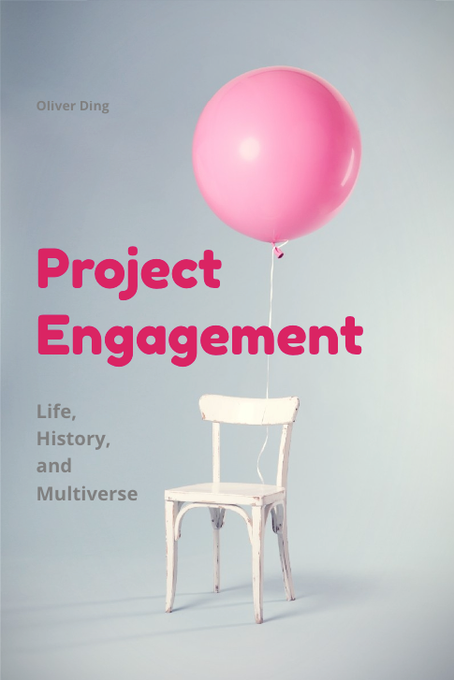
You can find more details in Project Engagement (v2.1) as an Innovation Approach.
In June 2022, I read The Scientific Project of Sociology (Ping-keung Lui, 2010), which was originally a lecture series on sociology and philosophy for MA students at The Chinese University of Hong Kong. The book prompted me to ask a fundamental question:
Is Activity Theory a sociological theory?
Answering this question is challenging because Activity Theory is not a single, unified theory but rather a family of related approaches. The lack of an official definition led me to rethink its foundations, resulting in the development of several semiotic system diagrams.
This process exemplifies one form of Second-Wave Development—a return to subjectification. However, another form of development can take a different path, leading to new branches of objectification.
A key example of objectification is The Activity Circle, which explores the relationships between Self, Other, Thing, and Think. This framework is particularly suited for analyzing objects with dual properties—both material and mental. This idea was inspired by cultural-historical psychologist Lev Vygotsky’s two types of mediating tools: technological tools and psychological tools.
The Activity Circle originally emerged in 2017 as the Activity-Relationship perspective. In 2021, I used it to bridge Activity Theory with Relevance Theory, resulting in a model called The Relevance of Zone.
In 2022, new insights led me to revisit and refine this model, ultimately renaming it Activity Circle.
6.7 Third-wave Development
Third-wave Development focuses on the dynamics of a project network and the role of creative thematic dialogue in knowledge engagement.
On September 15, 2022, I launched the Thematic Engagement Toolkit (v1.0), designed for exploring knowledge engagement, thematic conversation, controversy, and thematic reflection. The toolkit refers to a dialogue between two knowledge frameworks:
1. The Themes of Practice Approach (2019, 2021)
2. The Project Engagement Approach (2021, 2022)
The development of this toolkit was shaped by several conceptual "ECHOes", which played a crucial role in its final formulation.

The above diagram shows the following five sources that led to the notion of "Thematic Engagement".
- Themes of Practice
- Project Engagement
- Thematic Space
- Knowledge Center
- Thematics Controversy
From 2019 to 2022, there were six ECHOes between these five sources:
- Sept 29, 2020 - Echo 1: The "Hierarchy" of Human Activity
- Dec 26, 2022 - Echo 2: “Formation of Concept” and “Themes of Practice”
- April 2021 - Echo 3: The "Themes of Practice" Framework
- July 20, 2022 - Echo 4: Rethinking Activity Theory
- July 31, 2022 - Echo 5: Controversy Mapping and The Thematic Controversy Project
- Sept 6, 2022 - Echo 6: Grow A Knowledge Enterprise
When viewed together, these ECHOes form a thematic dialogue, revealing how ideas evolve through interaction across different domains. You can find more details in Slow Cognition: The Echoes of A Thematic Dialogue.
(A full version of this case study can be found in Slow Cognition: The Activity U Project and Creative Life Curation)
6.8 Reflecting on the Journey in 2025
The case study was conducted on November 16, 2022. Later, on December 31, 2022, I adopted the Ecological Transformation framework to reflect on the journey. See the diagram below.

Building on this reflection, I edited a book draft titled Appropriating Activity Theory: A Journey of Knowledge Engagement.
On December 4, 2024, I created a knowledge map tited World of Activity, featuring five models and six book drafts that capture my knowledge creation throughout this journey.

The core concept behind this curation is to use "World" as a metaphor to frame a theoretical toolkit centered on the Project Engagement approach. More details can be found in World of Activity (v1, 2024).
7. Case Study: Oliver Ding and the Theme of Curativity (2022)
From 2020 to 2022, I worked on a series of projects about knowledge curation. In October 2022, I reflected on the journey and created the Creative Thematic Curation framework.
This section revisits the first case study of the framework, for the full version, see Slow Cognition: The Creative Life Curation Framework.
7.1 Explore Widely
My journey into theoretical learning began in 2014. Before that, I was deeply engaged in digital nonprofit communities as a digital activist. However, between 2014 and 2015, I shifted my focus from nonprofit activities to theoretical exploration, dedicating most of my spare time to studying ecological psychology, creativity research, and related fields.
Over the years, my learning trajectory expanded across multiple disciplines:
2014–2020: Ecological Psychology and Creativity Research
2014–2018: Action Science, Activity Theory and Cognitive Science
2018–2019: Practice Theory, HCI, Strategy and Work
2020: Social Theory, Social Media, Information Systems and Platform
This timeline highlights how social theory became my most recent area of exploration, reflecting a continued evolution in my intellectual pursuits.
7.2 Inquire Deeply
From 2015 to 2016, I focused on Ecological Psychology. I read many papers about Affordance Theory and Behavior Settings Theory.
From 2015 to 2016, I focused on learning James G. Gibson’s Ecological Approach to Visual Perception and Affordance Theory. I also read Ecological Psychologist Edward Reed’s books and Harry Heft’s Ecological Psychology in Context: James Gibson, Roger Barker, and the Legacy of William James.
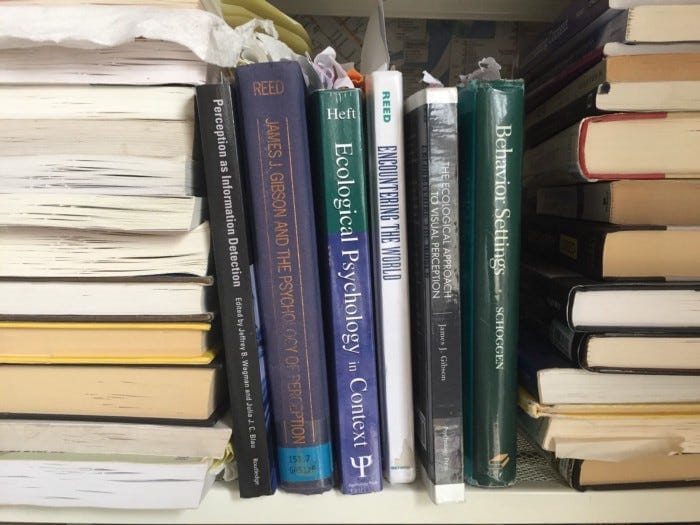
In 2017, I started learning Roger G. Barker’s Behavior Settings theory. In 1989, Phil Schoggen published a book titled Behavior Settings which is a revision and extension of Roger G. Barker’s classic Ecological Psychology: Concepts and Methods for Studying the Environment of Human Behavior (1968). Karl A. Fox wrote a chapter for Schoggen’s edition and mentioned Goffman’s Frame Analysis and other ideas about social practice.
Then, I started reading Goffman’s Frame Analysis and other social theories. Eventually, Social Practice theories became the new focus of my learning journey.
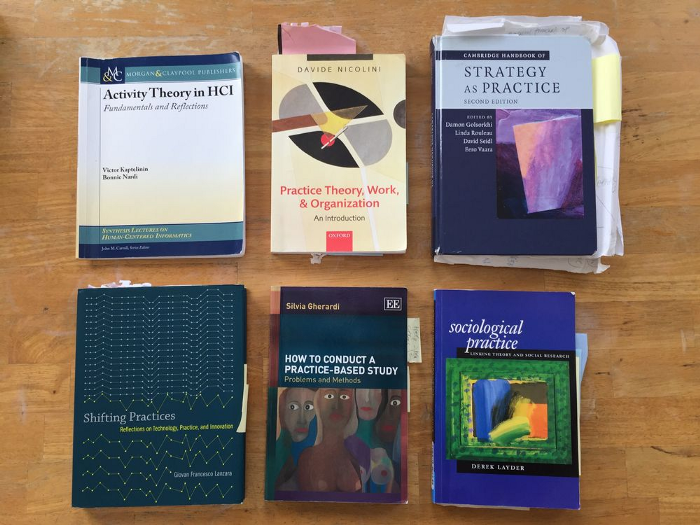
Another key focus of my studies is Activity Theory. I began learning Ecological Psychology and Activity Theory in 2014. While Harry Heft does not explicitly mention Activity Theory in his book, he suggests that Lev Vygotsky’s Cultural-Historical Theory of Psychology—a foundational influence on Activity Theory—offers a way to extend Ecological Psychology into the realm of social analysis. Additionally, some scholars view Activity Theory as a valuable approach within Social Practice Theories.
The image above displays several books from my reading list on Social Practice Theories.
7.3 Crystallize Thematically
I have been working in the curation field for over ten years. I served as the Chief Information Architect of BagTheWeb, an early content curation tool that we launched in 2010. This experience inspired my long-term commitment to the Curation theme.
In April 2018, I reflected on the early BagTheWeb project, applying the Activity System model and the concept of the “mediated artifact” from Activity Theory to develop a framework for understanding both the BagTheWeb project and the broader activity of curation.
In August 2018, I revisited the “Activity Theory — BagTheWeb” project. Having started my studies in Ecological Psychology, Activity Theory, and other related theories around 2014, I recognized the need to conduct at least one empirical study using these theories to advance my intellectual development. I saw this as the “one more step.”
From August to September 2018, I reviewed academic papers on Curation and Practice Theories. On September 14, 2018, I wrote an outline for a thesis titled "Curation Theory: Container, Theme, and Action."

The outlines indicate that I intended to use the Curating Activity System model as the starting point for building Curation Theory. I also planned to use the BagTheWeb case study as empirical research.
From October 2018 to March 2019, I expanded the project into a 615-page draft. The outcome of this work is a book titled "Curativity: The Ecological Practice Approach to General Curation Practice."
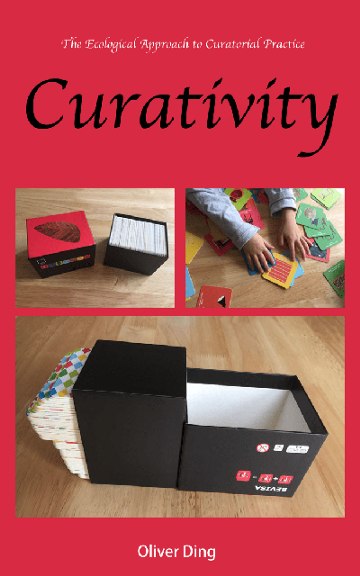
You can find more details in Slow Cognition: How did I develop Curativity Theory?
7.4 Work Deeply
After March 2019, I continued to revise Curativity and develop the Ecological Practice Approach as a new project. Regarding the direction of Curativity Theory, I began exploring practical applications, such as:
- Knowledge Curation
- Action Curation
- Life Curation
- Platform Curation
I wrote a chapter on knowledge curation in the book Curativity. In the context of academic knowledge curation, I referenced Dean Keith Simonton’s chance-configuration theory, as well as Victor Kaptelinin and Bonnie A. Nardi’s case study on scientific curation, "Curation at Ajax," and qualitative research methodologies. For practical knowledge curation, I focused on the concept of the Cognitive Container, which is central to Curativity Theory.
In 2020, I decided to apply Curativity Theory to Knowledge Building, which led to the initiation of the Knowledge Curation project—a work that eventually led to several books.
The mission behind the Knowledge Curation project is to bridge the gap between theory and practice.
The Theory-Practice Gap is a critical issue across a range of disciplines, including education, organizational learning and development, community building, academic development, enterprise R&D, and professional service firms (PSFs), among others.
Finding an effective solution to close this gap could significantly enhance existing social systems related to knowledge production, knowledge application, and knowledge management, both at the individual and collective levels.
From 2020 to 2022, I developed a set of tools and ran several sub-projects.
- 2020: The HERO U framework | The Activity U project
- 2021: The Model of Knowledge Curation and Canvas | The D as Diagramming project
- 2022: The Thematic Space Canvas | The Life Discovery project
- 2022: The Thematic Engagement Toolkit | The Slow Cognition project
The outcomes have been highly rewarding. I produced a variety of knowledge products, including concepts, diagrams, canvases, methods, toolkits, and more. Additionally, I wrote articles and edited books. On October 18, 2022, I edited a possible book to introduce the Knowledge Curation toolkit and closed the first phase of the project.
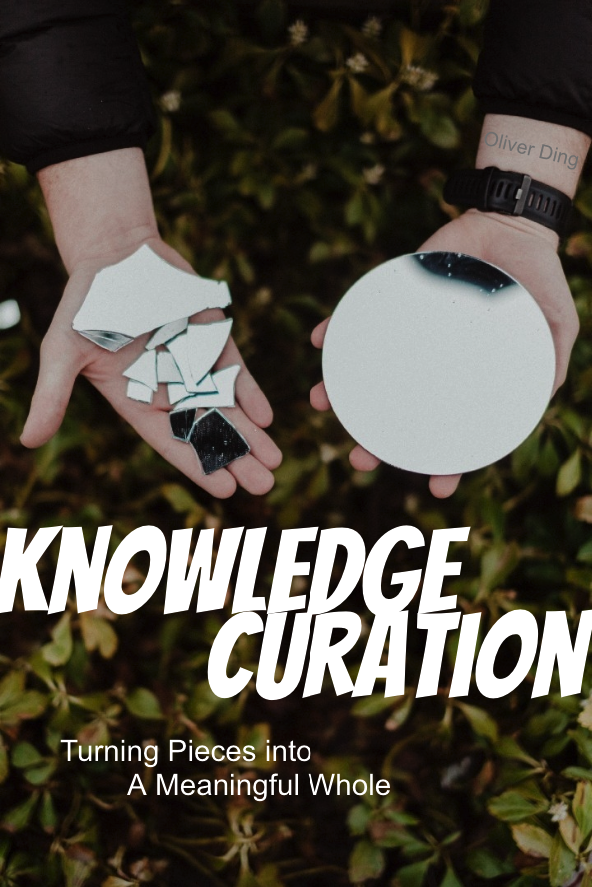
You can find more details in The Knowledge Curation Project (phase 1).
7.5 Play Widely
In 2022, I launched six Knowledge Centers to transform my book drafts and tools into learning programs and knowledge services:
- Curativity Center
- Activity Analysis Center
- Creative Action Learning Lab (CALL)
- Platform Ecology Center
- Life Strategy Center
- Thematic Analysis Learning Enterprise (TALE)
On September 2, 2022, I used Thematic Landscape Map to visualize the landscape of my “Curativity” knowledge enterprise. See the diagram below. For large diagrams and more details, refer to Slow Cognition: Mapping Thematic Landscape (Curativity, 2019–2022).

The Thematic Landscape Map uses three nested circles as a basic model.
- Theme: this inner circle is for displaying Themes and Books.
- Work: the middle circle refers to Projects and two types of Knowledge Frameworks: Abstract Models and Concrete Models.
- Play: the outer circle is about Programs that consider two types of things: Tools and Actions.
While the Theme circle and the Work circle focus on the individual work of knowledge makers, the Play circle refers to the collaborative space between knowledge makers and knowledge users.
Each of these three circles also addresses different aspects of complexity:
- Theme: The cognitive aspect of complexity is the primary challenge.
- Work: The material aspect of complexity is the primary challenge.
- Play: The social aspect of complexity is the primary challenge.

The above model is inspired by a model of Project-oriented Activity Theory. It represents three types of Objectification of a Concept.
7.6 Second-wave Development
In 2022, I began developing the Model of Curated Mind. This is not part of the original Curativity Theory or my 2019 book, so I returned to the Explore Widely and Inquire Deeply stages.
It took several movements to arrive at the Model of Curated Mind.
First, I focused on closing the D as Diagramming project (Phase 1) in December 2021. To develop a framework for understanding diagramming activity and related social practices, I re-introduced an integrated epistemological framework with four perspectives. However, I later realized that this framework not only applied to diagramming but also served as a curated framework for my psychological knowledge, as it encompasses four major psychological theoretical approaches.
Second, I began developing the Thematic Space Canvas for Developing Tacit Knowledge in January 2022. I used the "Flow — Story — Model" metaphor to describe the context of developing tacit knowledge.

Third, in March 2022, I worked on developing the Optimal Context Canvas. The canvas consists of two spaces: the Inner Space, which refers to Proximal Contexts, and the Outer Space, which focuses on Pervasive Contexts. These two types of social contexts were inspired by Self-Determination Theory (SDT).
Later, I coined the terms “Proximal Mind” and “Pervasive Mind” to develop an ecological approach to the mind. I also combined these two concepts with the "Flow — Story — Model" metaphor. The result is the following model.

The Curated Mind offers a holistic view of the mind, encompassing both individual actions (referred to as the proximal mind) and collective practices (referred to as the pervasive mind) as interconnected and meaningful components.
The whole process jumped from Objectification to Subjectification.
7.7 Third-wave Development
In 2022, I launched several knowledge centers. In September of that year, I started the Life Curation Project, which can be seen as a collaborative project between the Curativity Center and the Life Strategy Center.
Originally, the Life Strategy Center focused on Life Strategy and the Anticipatory Activity System (AAS) framework. However, Life Curation emerged as a valuable strategy for life development as well.
At this stage, we observed a thematic dialogue, which marked the beginning of my journey into Third-Wave Development.
7.8 Reflecting on the Journey in 2025
The case study was conducted in October 2022, and I continued to work on related projects thereafter.
By January 2025, I reflected on the journey from March 2019 to December 2024 and summarized it in three key dimensions:
- Knowledge Curation
- Action Curation
- Mental Curation
Additionally, I created a knowledge map to highlight the key elements of Curativity Theory. For more details, you can refer to The Landscape of Curativity Theory (January 1, 2025).
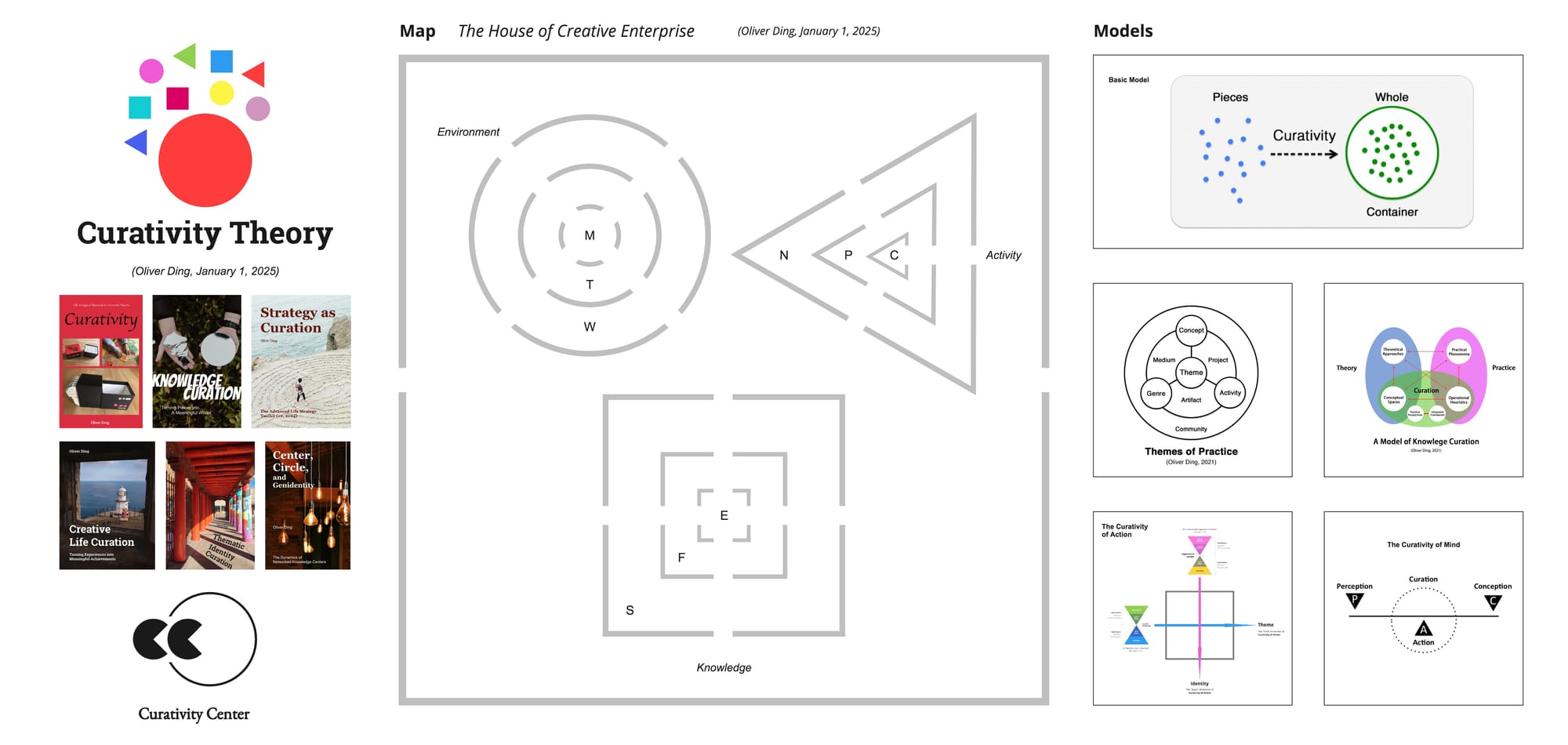
If we apply the Creative Thematic Curation framework to discuss the journey, the three dimensions—Knowledge Curation, Action Curation, and Mental Curation—can be seen as part of the First-wave Development.
A branch of the "Curativity" thematic enterprise is the concept of "Themes of Practice," which was developed as an independent thematic enterprise in 2021. Later, it evolved into Thematic Space Theory from 2022 to 2024. I would like to claim that this marks the Second-wave Development of the "Curativity" thematic enterprise.
The Thematic Identity Curation project, which began in 2024, integrates the concepts of "Theme" and "Identity." This project is a significant development of the "Curativity" thematic enterprise, as it weaves together the following projects into a cohesive network:
- Curativity Theory
- Thematic Space Theory
- The Project Engagement Approach
- GO Theory (The Genidentity - Opportunity Approach)

I claim that this project represents the Third-wave Development of the "Curativity" thematic enterprise.
8. Case Study: The Journey of Building Creative Life Theory (2023)
In October 2023, I revisited the development of Creative Life Theory from 2020 to 2023, exploring the journey through a series of knowledge frameworks. The journey is detailed in a series of articles (see links below).
- The Landscape of Creative Life Theory (v2, 2023)
- Part 1: First-wave Development
- Part 2: Second-wave Development
- Part 3: Third-wave Development
- Part 4: Three Themes of a Journey of Theory Building
- Part 5: Creative Dialogue and Mental Moves
- Part 6: Four Perspectives and Creative Identities
- Part 7: The World of Works and Five Possible Books
Part 1 to Part 3 use the Creative Thematic Curation framework as a model to discuss the developmental pattern of Creative Life Theory. Let's revisit this case study.
8.1 A Brief Overview of the “Creative Life Theory” Knowledge Journey
My journey of developing Creative Life Theory started with the CALL project in 2019. CALL stands for Creative Action Learning Lab, a project that embodies my passion for exploring Creativity and Action Science.
In 2020, I created the Pinwheel framework and focused on the Action-based Creativity direction. During this time, I also developed the Process-as-Product approach for studying creativity.
In 2021, I shifted towards the Knowledge Curation Project, where I created the diagram titled "The Path of Creative Life."
In 2022, I rediscovered the “Creative Life” diagram, using it to curate several frameworks together. This led to the birth of Creative Life Theory (v1.0), supported by four draft books.
In April 2023, I wrote Knowledge Engagement: Knowledge Center and Creative Life Theory, and developed Creative Life Theory (v2.0).
8.2 Multi-theme Development
Inspired by Ping-keung Lui’ creative life, I decided to commit to the Creative Life Theory project. On April 23, 2023, I made the diagram below and used it to frame my creative space.

The development of Creative Life Theory was influenced by the following four theoretical resources:
- Theoretical Sociology (Ping-keung Lui’ approach)
- Activity Theory
- Ecological Psychology
- The Psychology of Creativity
This journey was a multi-theme developmental process, involving several creative dialogues between each pair of these theoretical approaches.

The Psychology of Creativity
In 2020, I began developing a new approach to studying Action-based Creativity in the context of the platform age. In 2022, I started the Slow Cognition project, applying Howard E. Gruber’s evolving systems approach to conduct research about creative work.
Ecological Psychology
From 2019 to 2022, I worked on developing the Ecologial Practice approach, which is inspired by Ecological Psychology.
Activity Theory
From 2020 to 2022, I worked on the Activity U project and Activity Analysis Center, both of which were based on the principles of Activity Theory.
Theoretical Sociology
From 2022 to 2023, I worked on a project about Theoretical Sociology, which also influenced the development of Creative Life Theory.
The First-wave Development of Creative Life Theory is represented in the diagram below.

8.3 Explore Widely
I began my theoretical learning journey around 2014. From 2014 to 2018, I immersed myself in a wide range of books and papers on various theories.
The Psychology of Creativity became one of my key areas of interest, while Ecological Psychology introduced me to a new perspective on Action and Opportunity.
These two areas served as the seeds for the development of Creative Life Theory.
8.4 Inquire Deeply
From 2019 to 2022, I worked on several projects related to creative action and creative work, developing several related ideas.
In 2019, I found CALL (Creative Action Learning Lab) as my personal studio to explore Creative Action. In February 2020, I developed the Pinwheel framework. Later, on July 8, 2020, I wrote an article titled The NICE Way and Creative Actions.

The article started with the picture above and introduced the Process-as-Product approach for studying Action-based Creativity in the age of platforms.
After that, I thought I had accomplished my work in the field of Creativity, so I shifted my focus to Knowledge Curation and Creation.

The new journey began with the picture above which is part of an article titled HERO U — A New Framework for Knowledge Heroes. I made a diagram, HERO U, which I used to discuss knowledge curation and creation. This led to the Activity U project and three book drafts. More details can be found in Slow Cognition: The Activity U Project and Creative Life Curation.
Three significant projects contributed to the development of Creative Life Theory:
- CALL: Network of Enterprise (2020–2021)
- The Slow Cognition Project (2022)
- Building A Knowledge Enterprise Activity (2022–2023)
Both CALL: Network of Enterprise (2020–2021) and The Slow Cognition Project (2022) were inspired by Howard E. Gruber’s evolving systems approach to the study of creative work (1974, 1989).
On October 1, 2022, I closed the Slow Cognition project (phase II) and moved to the Creative Life Curation project.
In May 2022, I initiated a new project called Building A Knowledge Enterprise Activity (2022–2023). The core idea of this project was inspired by Project-oriented Activity Theory.

I used the Project Engagement approach to explore the concept of the Knowledge Center. Throughout this project, I developed a network of seven knowledge centers from May 2022 to May 2023.
8.5 Crystallize Thematically
From 2020 to 2022, I worked on the Knowledge Curation project. On September 18, 2022, I closed the Knowledge Curation project (phase 1) and moved to a new project: the Life Curation project.
On October 26, 2023, I decided to curate several frameworks about Creative Life Development together. Since these frameworks came from different theoretical perspectives, I needed to find a new approach to theoretical curation.
My solution was to adopt ideas from Ping-keung Lui’s theoretical sociology, particularly his “Ontology — Realism — Hermeneutics” schema and sociological semiotic system. I completed this theoretical curation in one day, and this seemingly small project had a profound impact on my creative work. It helped establish the foundation for Creative Life Theory (v1.0).
At the end of 2022, I edited two possible books: Creative Life Curation and Advanced Life Strategy.
8.6 Work Deeply
In September 2022, I created a series of new diagrams to map my creative journey from 2020 to 2022:
- Mapping Thematic Landscape
- Mapping Thematic Journey
- Mapping Thematic Dialogue
These diagrams, along with case studies, inspired me to develop a set of units of analysis for Creative Life Theory (v1.0).

Later, on November 14, 2022, I created the second semiotic system diagram, expanding upon the first semiotic system diagram.
8.7 Second-wave Development
A key theoretical resource for developing Creative Life Theory is Ping-keung Lui’s theoretical sociology, particularly his “Ontology — Realism — Hermeneutics” schema and sociological semiotic system.
Ping-keung Lui, a theoretical sociologist, was the Principal Lecturer (retired) at the Department of Applied Social Science at The Hong Kong Polytechnic University. Lui aims to build a new theoretical sociology as a potential paradigm for the discipline. In 2007, he published a Chinese book titled Gaze, Action, and the Social World, where he presented his account of theoretical sociology.
Although I did not read Gaze, Action, and the Social World in the fall of 2022, Lui mailed the book to me in December 2022. I read it from January to April 2023, making 15 notes across a total of 228 pages. During this time, I reflected on the following three projects while engaging with Lui’s theory development:
- The Knowledge Engagement Project
- The Creative Life Framework
- The Theme of “Value Circle”
As I engaged with the material, I also developed several new frameworks that formed the Creative Life Theory (v2.0).
I consider this phase of development as the second-wave development of Creative Life Theory.

Why did I consider the Thematic Engagement project and the Value Circle project as part of the Second-wave development?
I used a unique approach to develop theory and theoretical concepts, combining both conceptual work and practical work. While developing the concept of the “Knowledge Center” as a core concept of the Creative Life Theory (v2.0), I also worked on running several Knowledge Centers.
In January 2023, I launched TALE (Thematic Analysis Learning Engagement) to host the Thematic Engagement project. Over the next several months, it evolved into a Thematic Transformation Hub.
In July 2023, I updated the theme of “Value Circle” and re-contextualized it to refer to a project focusing on the dynamics of networked knowledge centers.
8.8 Third-wave Development
On September 28, 2023, I realized that I had entered into a creative thematic dialogue between two themes:
- Theme (Concept)
- Platform (Project)
I framed this as the third-wave development of Creative Life Theory, as shown in the diagram below.

This case study was conducted in October 2023. At that time, it felt too early to discuss the third-wave development of Creative Life Theory, and I noted:
This is the newest development of third-wave development. It just started in July 2023. It may be too early to frame these projects as the third-wave development of Creative Life Theory.
But, this is the value of using the Creative Life Curation framework to reflect on the journey.
Now, I would like to confirm that the creative dialogue between “Theme (Concept)” and “Platform (Project)” should not be considered the third-wave development of Creative Life Theory. In fact, the second-wave development had not been completed at that time.
On May 31, 2024, I edited a possible book titled Center, Circle, and Genidentity (book v1.0, 2024) and closed the Value Circle project. This marked the official end of the second-wave development of Creative Life Theory.
8.9 Reflecting on the Journey in 2025
What are the major developments in the theory after October 2023?
In March 2024, I completed my 30th possible book and conducted a Creative Life Curation project, reflecting on the journey of drafting 30 books from 2019 to 2024.

The reflection inspired a shift in focus, moving from Theory-building back to Intervention and Curation.
This insight ultimately led to the development of Strategic Life Theory in 2024.
On October 4, 2024, I used three thematic maps to curate ideas from the Ecological Practice approach, the Project Engagement approach, and Curativity Theory. The outcome was the Strategic Life Development framework. Later, I recognized that I should use the “Strategic Life” theme to highlight the “Strategy” aspect of human life.
This theme gave rise to a series of projects and several possible books. See the diagram below.
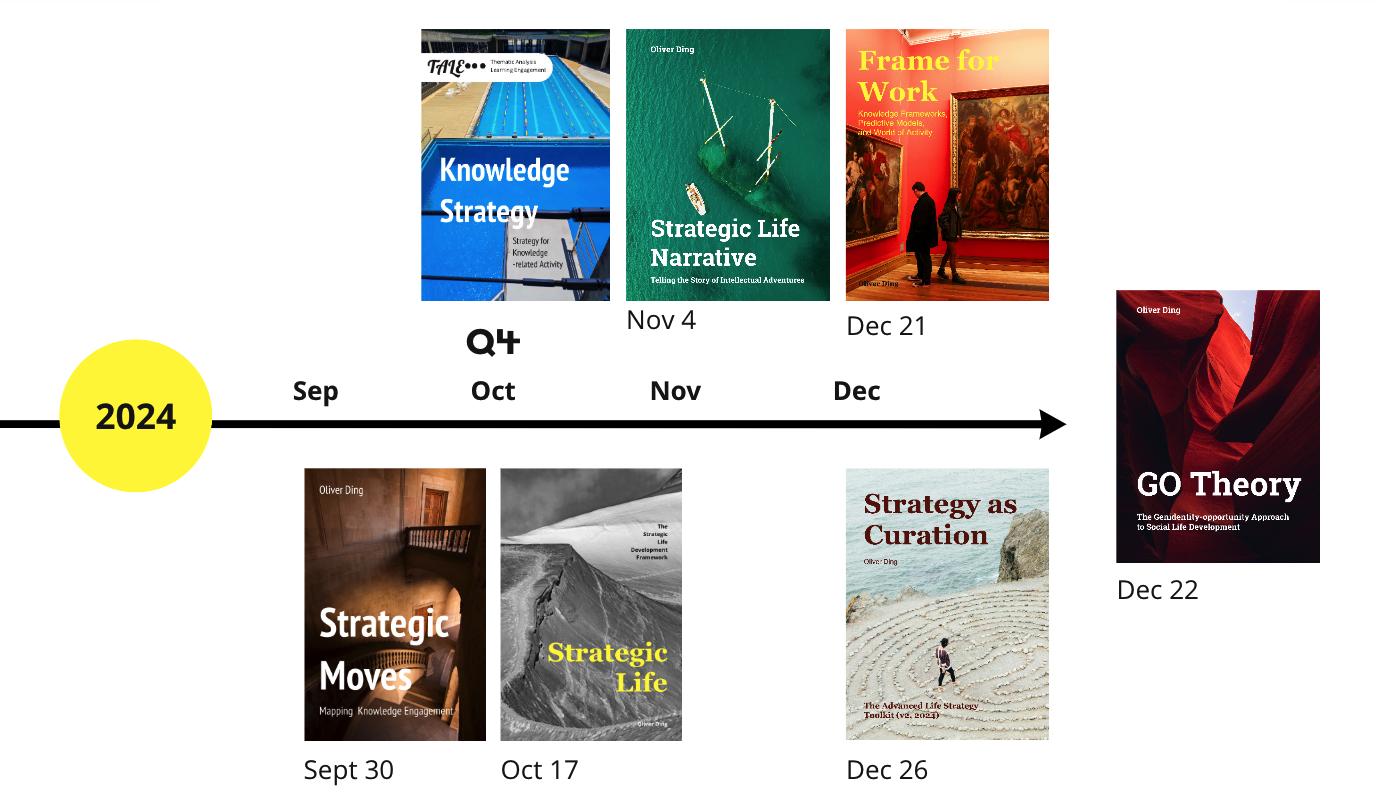
The “Strategic Life” theme inspired me to reflect on the evolution of my creative journey — from Creative Life to Strategic Life.
In 2023, I drafted a book titled Creative Life Theory. In 2024, the “Strategic Life” theme evolved into Strategic Life Theory. Together, these themes suggest a new path toward developing a comprehensive theory of human life: addressing one aspect at a time.
I would like to claim that this is a creative dialogue between the "Creative Life" theme and the "Strategic Life" theme.
This evolution also led to a new project called GO Theory (the Genidentity - Opportunity Approach), a creative dialogue between Creative Life Theory and the Ecological Practice Approach.
This marks the real third-wave development of Creative Life Theory.
9. Mapping One Creative Journey
The Creative Thematic Curation framework was initially developed to map a single creative journey, encompassing a series of related projects.
While it was originally intended as a research tool for the Creative Life Curation method, it has since been adapted as a strategic tool for both reflection and anticipation. In this context, it is referred to as Strategic Thematic Exploration. See the diagram below.

We can also use the vertical view (which is not the conventional approach for visually representing a timeline). See the diagram below.

By combing the “Past — Present — Future” structure with the “Thematic Curation” framework, it prompts three key questions:
- What have you done in the past?
- What are you doing in the present?
- What will you do in the future?
To answer three questions, you need to:
- Sort projects you have done, are doing, or will do around a central theme and its related network.
- Map your journey to the Creative Thematic Curation model and locate where you currently stand.
- Explore the next phase using the Creative Thematic Curation model to identify opportunities for new projects.
Additionally, there are several tools to assist you in this process. For example:
- Knowledge Discovery Canvas: Helps you understand the thematic space surrounding the primary theme.
- Strategic Curation Model: Aids in integrating pieces of experience, knowledge, and resources into a meaningful whole.
- Developmental Project Model: Supports the design of developmental projects.
- Anticipatory Activity System: Assists in building an advanced life strategy.
By doing so, the Strategic Thematic Exploration framework provides a comprehensive toolkit for understanding the journey of project engagement.
v1.0: 8,965 words - March 25, 2025
